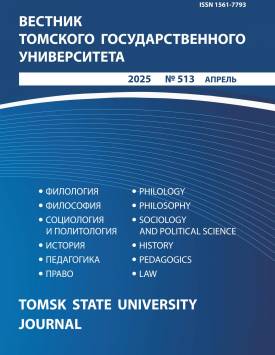The Karban ritual practice tradition: To the history of an Altai population group during the Great Migration Period
Relevant problems in studying the history of Altai in the last quarter of the 1st millennium BCE - the first half of the 1 st millennium CE include the interpretation of the multivariance of the burial rite of the Bulan-Koba culture population and the reconstruction of the interaction process between nomadic groups of different origins. The article presents the results of a synthesis of archaeological sources on the Karban burial tradition and also publishes materials from the burial of one of its benchmark complexes (Mound No. 33 at the Karban-I necropolis in Northern Altai). Materials from the excavation of over 700 objects have been considered, some of which demonstrate the features of this monument group. It is concluded that the distinctive features of the Karban ritual tradition are a small oval-shaped mound, a shallow grave pit, single inhumation of the deceased, orientation of the deceased with the head towards the wes, the absence of a buried riding horse, and variability in the intra-grave structure. It has been established that the "Karban people" constituted one of the groups of the polyethnic population of the Altai's Bulan-Koba culture, which lived in the region from the 2nd century BCE to the 5th century CE. The thesis about the participation of tribes from Eastern Kazakhstan and Tuva in their formation is substantiated; these tribes migrated to Altai due to the expansion of the Xiongnu Empire into the northern regions of Central Asia at the end of the 3rd-2nd centuries BCE. In the ethno-social stratification of the Bulan-Koba culture nomads, the "Karban people" generally occupied a rather low position. Judging by the discovered grave goods, the transformation of the "Karban" material culture was based on the reworking of prestigious categories of items from Xiongnu and Xianbei traditions, reflecting the general trends in the development of the material complex of Altai pastoralists in the last quarter of the 1st miUennium BCE - first half of the 1st miUennium CE. The most indicative changes occurred in weapon sets, military equipment, and adornments. The historical fate of the bearers of the Karban tradition remains unknown. The available archaeological materials demonstrate their departure or complete assimilation by a population group that migrated to Altai around the middle of the 5th century CE and formed the basis of the early medieval Turkic community. It can be stated definitively that elements of the Karban tradition are not traceable in the burial practices of the designated region or adjacent territories in the second half of the 1st millennium CE. The materials from the excavation of one of the indicative burials at the eponymous Karban-I necropolis, dating to the Xianbei period, introduced into scholarly discourse, expand and refine existing ideas about the nature of ethnocultural and social processes that took place in Altai during the Great Migration Period. The authors declare no conflicts of interests.
Keywords
Altai, archaeological complex, Bulan-Koby culture, Karban tradition, Great Migration Period, burial riteAuthors
| Name | Organization | |
| Seregin Nikolai N. | Altai State University | nikolay-seregin@mail.ru |
| Demin Mikhail A. | Altai State Pedagogical University | nikolay-seregin@mail.ru |
| Matrenin Sergei S. | Altai State University | matrenins@mail.ru |
References

The Karban ritual practice tradition: To the history of an Altai population group during the Great Migration Period | Vestnik Tomskogo gosudarstvennogo universiteta – Tomsk State University Journal. 2025. № 513. DOI: 10.17223/15617793/513/19
